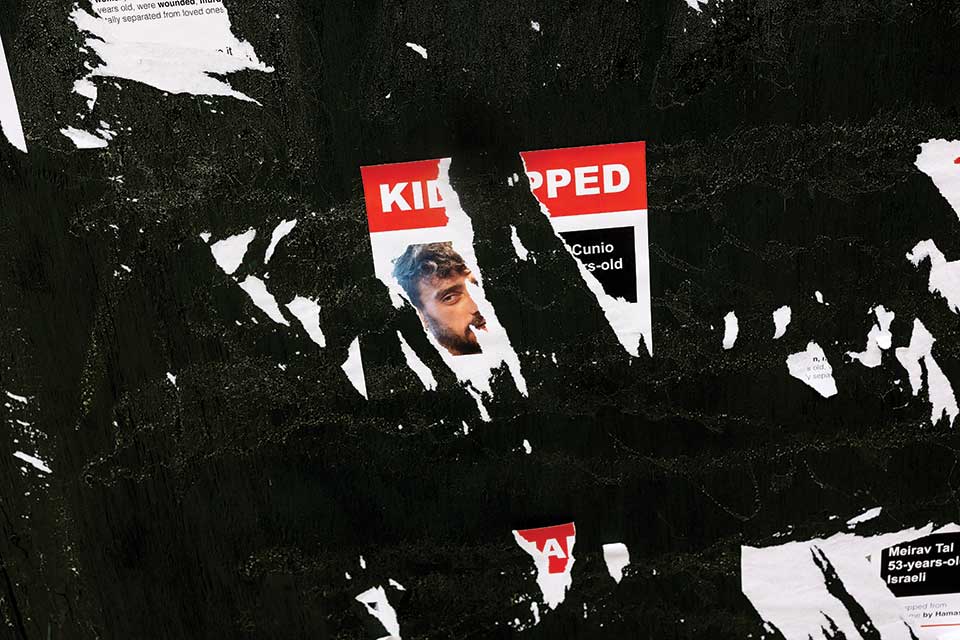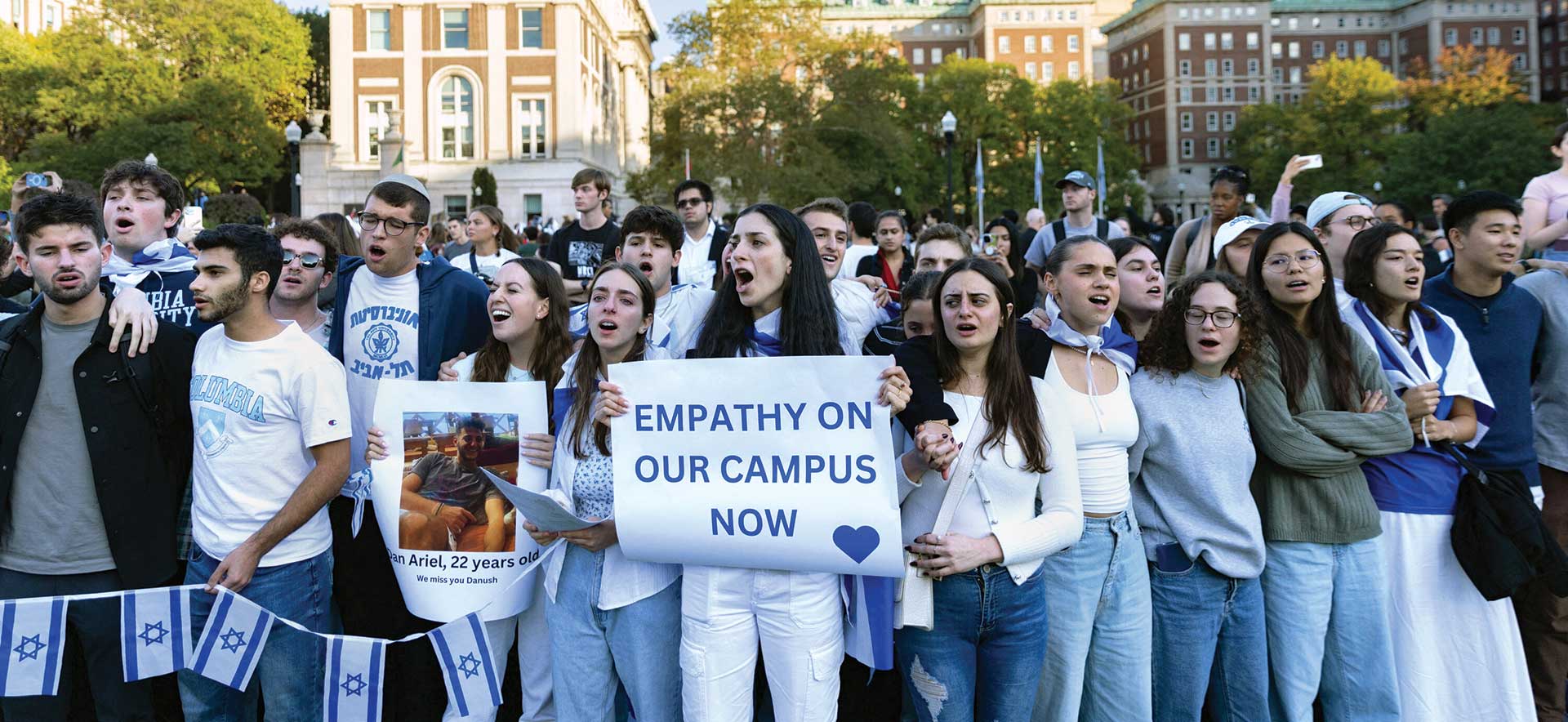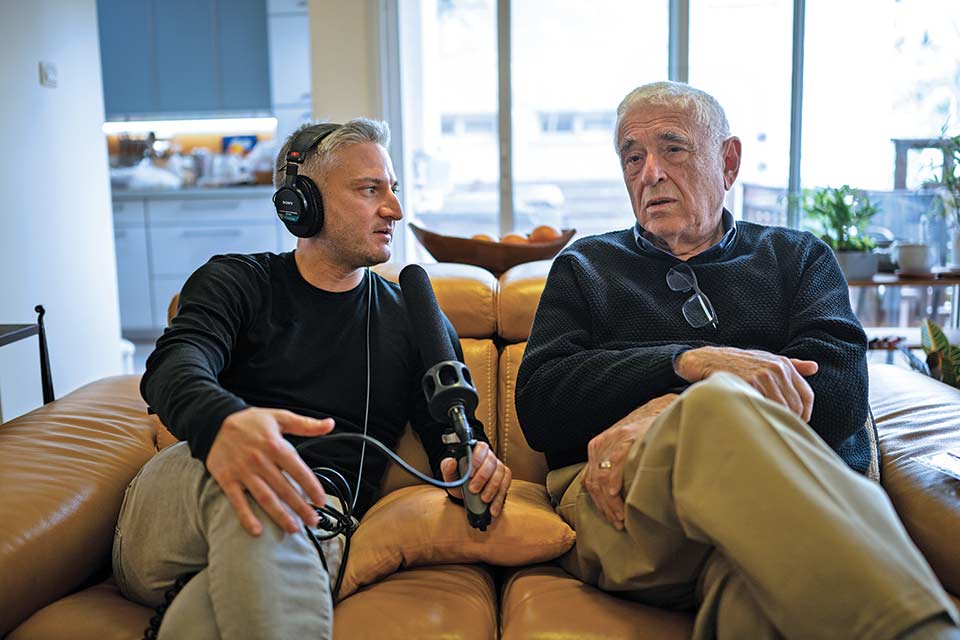The Crisis of Antisemitism on College Campuses
In the wake of the Israel-Hamas war, Jewish undergraduates across the U.S. are experiencing growing hostility.

Photo Credit: Getty Images
By Laura Gardner, P’12
For nearly a decade, Len Saxe, the Klutznick Professor of Contemporary Jewish Studies and director of Brandeis’ Cohen Center for Modern Jewish Studies, has examined antisemitism on U.S. college campuses.
He and his colleagues at the center have asked young Jewish adults at dozens of schools — large and small, public and private, land-grant and Ivy League — about their perceptions and experiences of antisemitic hostility on their campus, first in 2016, then again in late 2023. The two surveys, both conducted in the shadow of war, amid the complex emotions war engenders, yielded snapshots taken “at a specific moment and in a specific context,” says Saxe.
Viewed together, they depict a troubling trend of growing antisemitism experienced by Jewish college students.
In 2016, in the aftermath of the 2014 Gaza war, Saxe and his colleagues surveyed American Jewish students at 50 colleges with high Jewish populations. “Headlines suggested antisemitism was rife across campuses, but we were pretty sure this wasn’t the case,” says Saxe. “And that’s what we found — antisemitism was a serious problem at some schools, but at most schools we surveyed Jewish students did not experience hostility and felt secure.”
That study uncovered “hot spots” of antisemitism at both public and private universities. More than 25% of Jewish students “somewhat” agreed that anti-Jewish hostility existed on their campus but fewer than 10% “strongly” agreed. Some surveyed schools reported virtually no anti-Jewish hostility.
All that changed on Oct. 7 when the terrorist group Hamas invaded Israel, maiming and killing more than 1,200 Israelis, mostly civilians, and taking more than 200 hostage, sparking an all-out war in the Gaza Strip.
Since then, Hamas and other terrorist groups have launched thousands of missiles into Israel, tens of thousands of Palestinians have been killed, and Israeli casualties exceed 1,400.
The conflict immediately fueled college protests around the world, including at Brandeis, where a pro-Palestinian demonstration in November “devolved into the invocation of hate speech,” according to President Ron Liebowitz. Seven people, most of whom were not connected to Brandeis, were arrested.


Saxe and associate research scientists Graham Wright and Shahar Hecht went into overdrive to understand how Jewish students were being affected by the Israel-Hamas war. The researchers created a new survey, which largely replicated the 2016 study, to assess levels of antisemitism and anti-Israel hostility on campuses.
The survey was sent online to more than 20,000 young adult Jews who had applied to Birthright Israel, a program that seeks to build connections between young American Jews and Israel. More than 2,000 Jewish college students at 51 U.S. campuses — collectively home to more than 100,000 Jewish students — responded. (Saxe describes the survey respondents as “broadly representative” of Jewish students, while noting they are slightly more connected to Jewish life and Israel than those not engaged with the Birthright program.)
A report titled “In the Shadow of War: Hot Spots of Antisemitism on U.S. College Campuses” was published in late December, detailing the data the Cohen Center researchers compiled. The findings were sobering.
The 2023 survey indicated rates of hostility were about twice that shown by the 2016 study.
“Antisemitism is through the roof on college campuses,” says Saxe, “much more prevalent in 2023 than it was in 2016.”
In fact, since the Israel-Hamas war began, multiple surveys, in addition to the Cohen Center’s, show American Jewish students are experiencing a dramatic increase in feeling unsafe on campus and report increasing numbers of antisemitic incidents.
“Our survey was designed to give voice to Jewish students,” Saxe wrote in a Feb. 5 opinion piece in Tablet Magazine. “We wanted to understand their reactions to the war and their campus climate; specifically, their perceptions of the level of hostility toward Jews and Israel, as well as their concern about antisemitism on campus.”
He continued, “Many of our respondents commented that they were scared by what was happening on their campuses and, among other issues, afraid to be recognized as Jewish.”
Although the Cohen Center researchers broke down the 2023 findings by school, they decided against including a U.S. News & World Report-style ranking in their report because they were concerned Jewish students might be dissuaded from applying to schools seen as hostile to Jews.
“Our goal is to identify better ways to address antisemitism,” says Saxe. “I don’t believe it would be a good thing to have only a few schools with Jewish students — and others without Jews — because of a perception of hostility.”
Instead, the researchers grouped schools into four quartiles, ranked from most- to least-hostile on the basis of how survey respondents answered questions about campus hostility associated with Jews, Israel, and antisemitism.
Schools in the most-hostile group included Boston University, Columbia, and New York University. Schools in the second-most-hostile quartile included Baruch College, Emory, and Tufts. The third quartile included Temple University, Syracuse, and Northeastern. And the fourth quartile — the least-hostile group — included Brandeis, Duke, Tulane, and Penn State.
Across the four groups, there was substantial variation in hostility scores. Students at the most-hostile universities were five times more likely to agree “very much” that their campus was hostile to Jews and Israel than students at schools in the least-hostile category, says Saxe.
Eighty-five percent of the respondents in the most-hostile group agreed at least “somewhat” that there was a hostile environment toward Jewish students on their campus, with 23% “strongly” agreeing. And 94% of these respondents said there was a hostile environment toward Israel.
A third of all survey respondents said they had experienced anti-Jewish insults or harassment, either on social media or, particularly at the most-hostile schools, in person.
Even at the least-hostile schools, almost half the respondents agreed at least “somewhat” that there was a hostile environment toward Jews, and 63% of respondents agreed at least “somewhat” that there was a hostile environment toward Israel. Twenty-three percent were “very much” concerned about antisemitism on their campus.
Virtually all the students surveyed expressed favorable opinions about the Israeli people and said they felt highly connected to Israel, but only 56% felt that way toward the Israeli government. “They also expressed deep concerns about the human cost on both sides of the conflict,” Saxe writes in the study.
What is clear, says Saxe, is that antisemitism is being expressed in new ways. Traditional tropes and stereotypes still fuel Jew hatred, but criticism of Israel now plays a central role in anti-Jewish hostility.
For example, the survey asked to what extent respondents felt blamed for the Israeli government’s actions because they are Jewish. At schools with the lowest levels of hostility, about 9% said they were often blamed for Israel’s actions; 18% of respondents on the most-hostile campuses said they felt blamed.
At the institutions with the most antisemitic hostility, 66% of respondents said they were “very concerned” about antisemitism related to criticism of Israel.
Where is the antisemitic hostility coming from? Largely from non-Jewish students on the political left, says Saxe. Right-leaning students may be more overtly hostile toward Jewish students, but politically left students make up the majority of college students.
Saxe and his colleagues are focusing much of their current work on understanding the views of these left-leaning students. They are also trying to pinpoint the factors that promote antisemitism on campus, as well as potential interventions. Critical questions remain: What school-level factors promote hostility? When does criticism of Israel cross the line into antisemitism? How does antisemitic hostility affect the lives of Jewish students and the educational climate?

In addition, Saxe says, the researchers are trying to understand “the impact of universities exercising their legal and moral authority to counter antisemitism.” He believes university leaders and faculty have a responsibility to protect Jewish students from hateful acts and from speech that calls for the elimination of Jews or denies Jews’ right to live in Israel.
“Apparently, some university presidents believe that Jewish students are not harmed by discourse that holds all Jews responsible for Israel’s actions and echoes Hamas’ call for the elimination of Jews,” Saxe wrote in his Tablet Magazine op-ed, a reference to the equivocating congressional testimony given in December by three university presidents quizzed about hate speech on their campuses. “That such discourse is associated with threats and acts of violence against Jewish students is also ignored.”
Part of the larger problem, says Saxe, is that campuses, even as they grow more diverse, have not succeeded in creating a deep sense of community “to help students feel like they are all in this together.” Adopting a “posse” system — through small-group activities, coursework, and team building, for example — could help build a sense of community and belonging among all students.
Antisemitism has long been a bellwether for other types of discrimination, Saxe says: “Louis Brandeis said the suffering of Jews due to injustices is the greatest tragedy in history. He also believed that Jews, like other ethnic groups, have the right to enact their unique identity, that doing so was central to American success.
“It’s important that we help universities figure out how to address the problem of antisemitism more effectively.”


